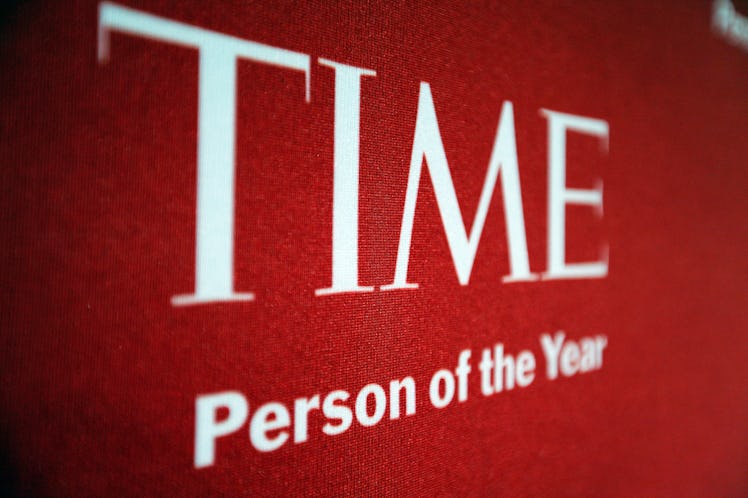
Here's The Short History Of Women On The Cover Of 'TIME' Person Of The Year
On Wednesday, Dec. 6, TIME Magazine announced "The Silence Breakers" as 2017 Person of the Year, applauding the women, (and two men) in numerous professions that brought forth a conversation about sexual assault and harassment by naming their perpetrators and providing a platform for other women to do the same. "The Silence Breakers" refers to the viral social media movement, #MeToo, that connected and validated women across the United States and internationally to come together and to take down the most powerful men in their industries by speaking up. While this is cover is quite the win for women, it's important to look at how many women have been TIME's Person of the Year before them, and how far we've actually come. Fear not, it's a short list.
1927 marked the first Man of the Year magazine cover, recognizing Charles Lindbergh as the first person to fly a solo, non-stop plane across the Atlantic Ocean from New York to Paris. Since then, every president has been selected at least once, as well as other influential leaders like Mahatma Gandhi, Winston Churchill (twice), and Adolf Hitler (in 1938). It wasn't until 1999 that TIME changed the award title to a more gender-neutral "Person of the Year." Prior to 1999, only four specific women had been awarded Woman of the Year (and one of those was a joint Man and Wife of the Year award). There was also one TIME honor given to a group of women before 1999.
In 1936, American socialite Wallis Simpson was featured on the cover for the noble deed of making Edward, the Prince of Wales, fall in love with her and abdicate the throne. The decision to voluntarily abdicate caused chaos in the Church of England, and not to mention, it was scandalous, considering Simpson was a divorced woman. According to the TIME article from 1936, Simpson was described as "the most-talked-about, written-about, headlined and interest-compelling person in the world." Luckily, we've come a long way in terms of pre-requisites and being considered worthy of Person of the Year.
The next year, in 1937, Soong Mei-ling, wife of Chiang Kai-shek, the Premier of the Republic of China, were jointly recognized for leadership during the Second Sino-Japanese war. TIME's article described them as "one supreme leader and his remarkable wife."
The third was Queen Elizabeth II in 1952, when she accepted the throne after her father, King George VI, died. Elizabeth, who was just 27 when she took over for her father, is now Britain's longest reigning monarch, sitting on the throne for 63 years and beating the record of her great-great grandmother Queen Victoria. Well deserved, Queen Elizabeth II.
The fourth Woman of the Year award, in 1975, was not designated to a specific woman, but to the "American Women" who broke the glass ceiling in the male-dominated workplace during the second wave of feminism. TIME selected 12 woman to feature: Susan Brownmiller, Kathleen Byerly, Alison Cheek, Jill Conway, Betty Ford, Ella Grasso, Carla Hills, Barbara Jordan, Billie Jean King, Carol Sutton, Susie Sharp, and Addie Wyatt. All of them came to be known as the "first woman" in their respective fields, ranging from tennis, politics, law, education, and activism. The 1975 award is the closest parallel to the 2017 "Silence Breakers" in recognizing women collectively starting an influential movement.
The fifth Woman of the Year award, before 1999, was given to Corazon Aquino in 1986, after being elected president of the Philippines. In the midst of civil unrest and demonstrations known as the People's Power Revolution in the Philippines, Aquino's husband and politician Benigno "Ninoy" Aquino was killed on behalf of the Philippine dictator Ferdinand Marcos. Aquino went on to restore democracy in the Philippines by becoming president and taking down Marcos, according to The Guardian.
Post 1999, there was one woman — and one group of women — that was awarded Person of the Year. The first was the 2002 "Whistleblowers," led by three women, Cynthia Cooper, Coleen Rowley, and Sherron Watkins, who testified in court after uncovering billions in fraud from a telecommunications company, WorldCom, and energy company Enron. It was considered one of the biggest accounting fraud incidents in history.
The last female cover before 2017 was two years ago, in 2015, when German Chancellor Angela Merkel was awarded for her role in the Greek debt crisis and the European Migrant crisis. In her write up, TIME referred to her as "the most powerful woman in the world."
TIME's 2017 write up featured the stories of 35 people, 33 of whom were women in Hollywood, journalism, tech, hotel management, education, and politics, and two of whom were men in Hollywood, Terry Crews and Blaise Godbe Lipman. For that reason, this year's triumph is not solely reserved for women. The 1975 cover story may be the stand-alone award given exclusively to a group of women. The list of women featured as TIME's Person of the Year falls short of the much longer list of women throughout history, publicly recognized or not, that paved the way for a movement like #MeToo to even happen. 2017 marks a victory for women globally, but that victory is just one moving piece in a broader story of triumph.